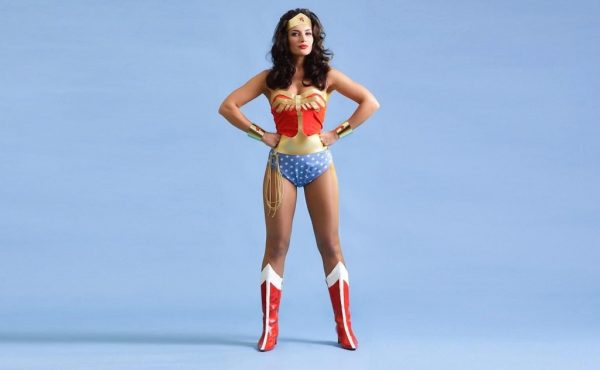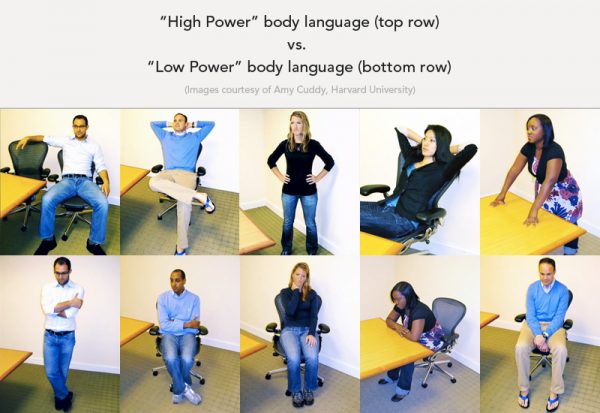If you’re like me, you probably always thought that proper posture was simply a matter of aesthetics–it makes you appear taller, slimmer and more confident. It takes a lot of discipline to maintain, though, so it’s perfectly understandable when we allocate our energy to nice clothing and makeup instead.
Bad idea. It turns out that proper posture isn’t just about looks. It affects the way we think, feel and act, and there’s a physiological reason for it: When we strike expansive poses, our testosterone (the dominance hormone) increases, and our cortisol (the stress hormone) decreases, causing us to feel powerful and in control. I learned this from Amy Cuddy’s 2012 TED talk that I only discovered this summer. Now whenever I’m feeling nervous before an event, I strike Amy Cuddy’s Wonder Woman pose that I write about on the Campbell & Kate blog.

After the TED talk, I marched to the library for her book Presence. The concepts of personal presence and power are much more nuanced than I can develop here, but when she discusses power, she doesn’t mean becoming a blustery bully. Instead, she means the ability to be ourselves and to tap into the resources available to us when we’re feeling calm and capable:
The way you carry yourself is a source of personal power–the kind of power that is the key to presence. It’s the key that allows you to unlock yourself–your abilities, your creativity, your courage, and even your generosity. It doesn’t give you skills or talents you don’t have; it helps you to share the ones you do have. It doesn’t make you smarter or better informed; it makes you more resilient and open. It doesn’t change who you are; it allows you to be who you are.
Slouching, on the other hand, causes and reinforces feelings of powerlessness. When we feel powerless, we
- see a challenge and focus on its risk rather than its benefits
- have impaired judgment and executive functions
- become self-absorbed
- seek to take up less space

Does “seek to take up less space” ring a bell with you? It does me. And guess what? According to Amy Cuddy, girls begin to take up less space in middle school.
Parents of young children–actually, anyone who’s observed young children–might have noticed that both boys and girls freely use expansive postures and movements. Unconstrained by cultural norms, little girls seem to be just as likely as little boys to throw their arms in the air, stand with their shoulders back, and plant their feet apart. But at some point, this appears to change: boys continue to expand, and girls begin to collapse. When my son entered middle school, I watched his female friends change the way they carried themselves. They began to draw their bodies inward, hunching their shoulders, wrapping their arms around their torsos, twisting up their legs and ankles, lowering their chins. There could be any number of reasons why this happens, but surely one of them is that girls, around that age, become more attuned to cultural stereotypes prescribing–accurately or not–what is attractive to the opposite sex. And this may be why your once effervescent child begins to wilt when she enters middle school.
Maybe girls do contract in order to appear attractive to boys, but Hourglassy readers know another reason. It’s boobs. Along with all the hormones that accompany puberty, breasts enter the picture, and it’s hard to know what to do with them. The easiest thing is to hold your books against your chest until you figure it out. If you have a mother who doesn’t know what to do with breasts either and has you walking around in a loose band that causes you to feel completely insecure, what will you do to feel protected? HUNCH OVER.

After a lifetime of hunching over, it’s no wonder that women of all cup sizes feel such a high when they are fitted into a bra that makes them feel secure. During my interview with Lisa Cole, Lisa observed that the rush from a good fit is so universal that companies like ThirdLove are trying to bottle and mass produce it. In Kimmay’s recent sports bra workshop, she shared:
Your breasts are the gateway to your heart. If a woman feels confused, ashamed, or uncomfortable in that area–because of her bra or otherwise–that will affect her heart, and her life. It’s my joy to help her find understanding, love, and comfort so that she can stand tall and lead with her heart. There are many ways I help a woman do that, but my favorite way is with a bra fitting and lingerie.
I would love for a researcher to compare a woman’s testosterone and cortisol levels in a badly fitting bra against a well-fitting one.
For girls who develop large breasts, however, it’s more than just “Get a good bra and stand tall.” There’s another factor that can’t be avoided even if your mom puts you in the right bra: Big boobs are prominent. They compel attention. Who didn’t wilt with Mia when she told us her seventh grade melon story?

In Amy Cuddy’s interview with Julianne Moore, Julianne says,
People feel the least present when they don’t feel seen. It’s impossible to be present when no one sees you. And it becomes a self-perpetuating process, because the more that people don’t acknowledge you, the more you feel you don’t exist. There’s no space for you . . . . Conversely, you are the most present when you are the most seen . . . and then people are always corroborating your sense of self.
When girls and women with large breasts stand up straight to be seen, we’re competing with our own chests for attention. It’s as if there really is no space for us because of the focus on our breasts. In order for our sense of self to be corroborated as more than the stereotypes associated with large breasts, our tendency is to slump. But the slumping backfires because it hides our powerful selves from ourselves.

An obvious solution is to trade bad posture for baggy clothes. That’s what I did for most of my life–baggy tees let me hide in plain sight. But there are better wardrobe solutions than defaulting to “hide me” mode. I give a workshop about big bust dressing strategies that allow us to be seen, and I blog about them here on Hourglassy. There are also posture techniques we can practice. Today I lift my chest up rather than out, thanks to comments left on my post about how hard it is to stand up straight without being all boob. Some women opt for a more extreme solution and get a reduction. I bet you’ve heard at least one woman exclaim how she wishes she hadn’t waited so long to do it. If reducing her cup size helps her take up more room in the world and claim her power, then I’m glad for her.

I no longer feel self-conscious about my chest. Sure, I only wear a 32F/FF now, but during a quick glance at a store window last Saturday, I was shocked to see how my boobs dominated my reflection. “They are NOT small at ALL,” I told my husband, who is still mourning the size 36H that I used to wear. (It probably helped that I was wearing my padded and very lifting Curvy Kate Starry Eyed bikini top under my tee shirt on our way to a swimming pool.)
Right now, I can think of three things that have helped me accept my large chest so that I can stand easily without hunching or hiding:
- writing this blog
- dialoguing with other women like me
- creating and finding clothes that fit my chest without requiring alterations or sizing up
What would have helped my seventh grade self? I have no idea! If only I had realized that good posture and expansive poses were a better way to face scary challenges than a new dress and eye shadow. Now I want other girls and women to know about that extra boost of testosterone available to them. As Amy Cuddy puts it,
When you see your daughters, sisters, and female friends begin to collapse in on themselves, intervene. Show them examples of girls and women in triumphant postures, moving with a sense of power, speaking with authentic pride. Change the images and stereotypes that kids are exposed to. We don’t need to tell women to be like men. But we do need to encourage girls not to be afraid to express their personal power. Let’s stop thinking about powerful postures as masculine and powerless postures as feminine. I’m not advocating that you sit with your knees wide apart or your feet up on the desk while in a meeting or that you engage in alpha body language in your interactions–whether you are a man or a woman. I’m telling you that you deserve to adopt open, comfortable postures and to take up your fair share of space regardless of your gender.
And regardless of your bra size.
Funny enough, my current trainer commented last week that I certainly don’t have a problem opening my chest- just dumping into my shoulders (a function of how I carry my work bag).
And it’s always interesting to analyze the body language of my coworkers. My boss rules the roost. I have a team member in another division who was terrified of her because she is so intense and in control (a year later, she’s less terrified but still very much impressed.) Unsurprisingly, she has very open, “strong”postures.
Katie, your comments the last time I blogged about posture were so helpful that I’m thrilled you commented again. I’ve been wondering about the effects of carrying a heavy bag on my shoulders . . . “dumping”, huh? Must look into this.
The idea is you’re collapsing on that side from habitually not supporting it (so because I carry a larger bag on my right side, my left side slumps and I “dump” my weight onto that side). I’ve been trying to switch sides each time I pick up my bag but it’s a hard habit to break.
I’ve had to do a bunch of rounds of physical therapy due to poor posture, I am amazed at how much pain has since disappeared.